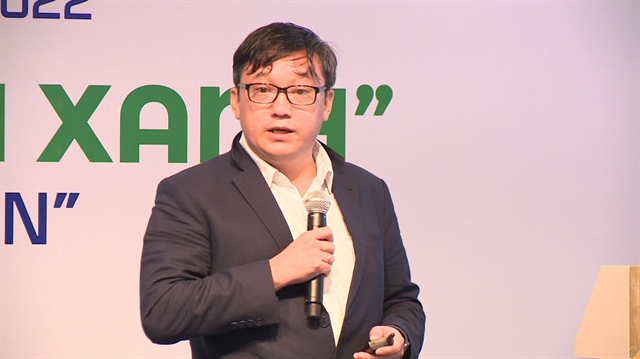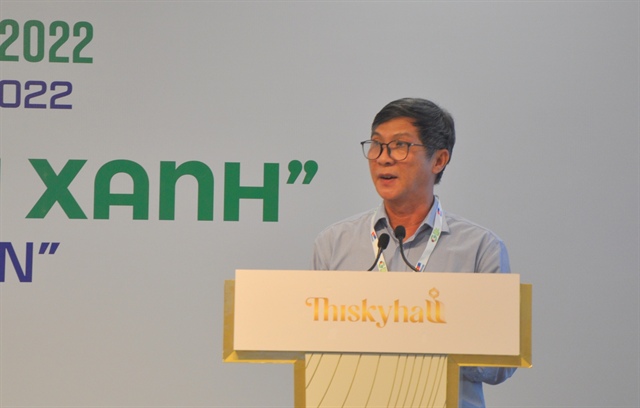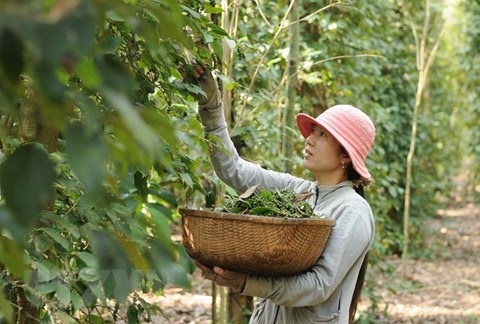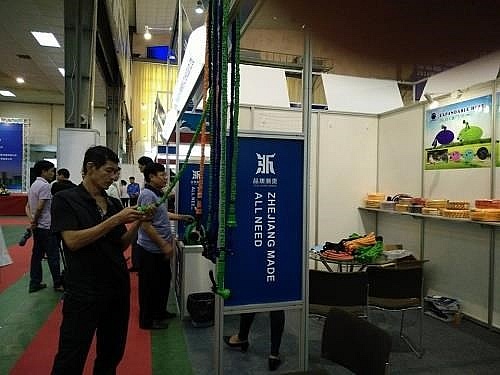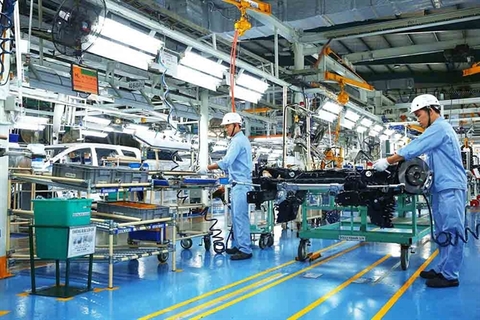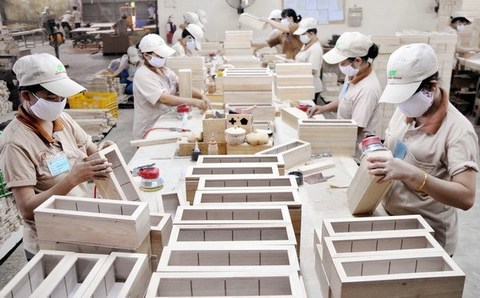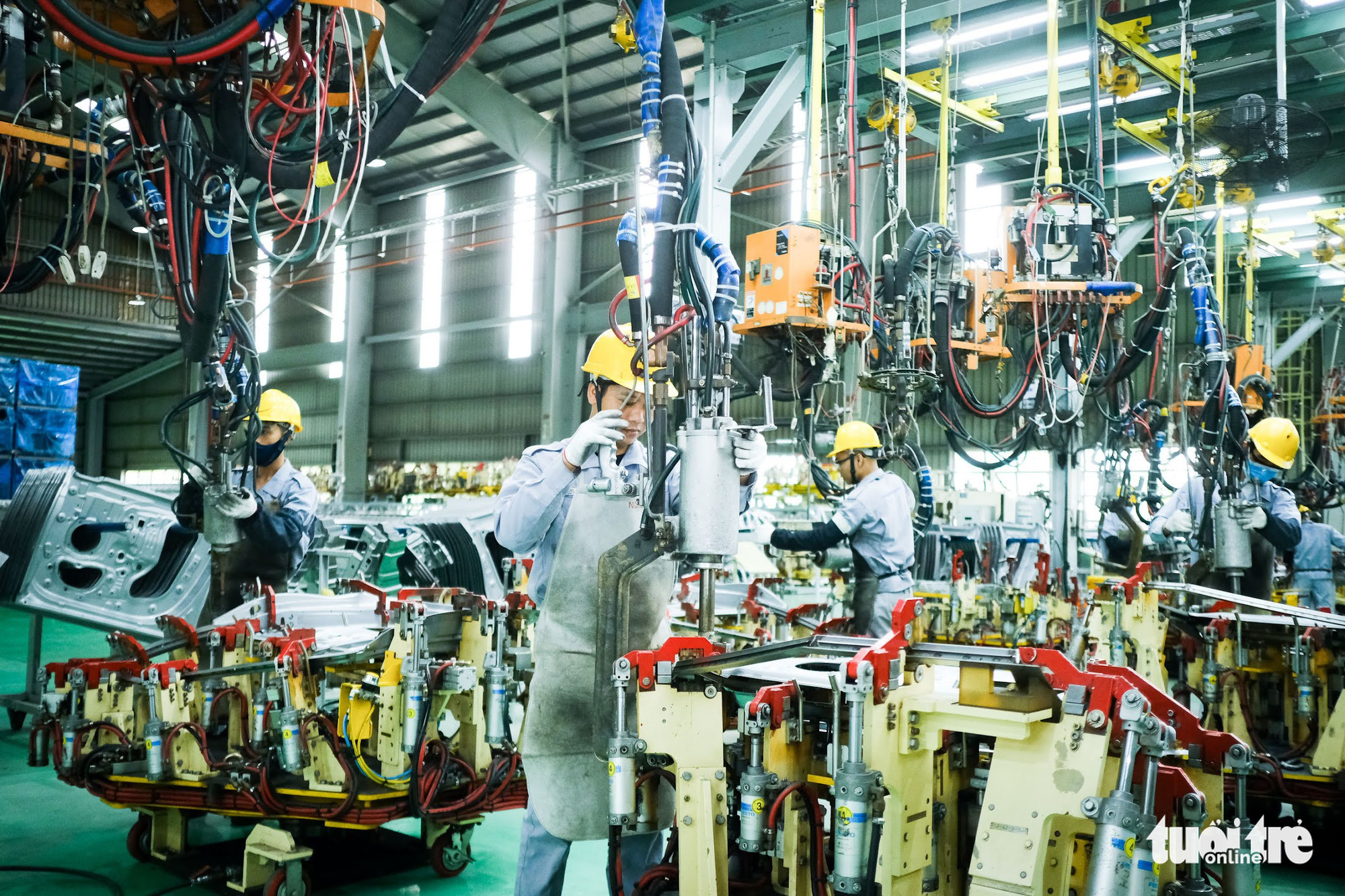The path to fostering green exports
The path to fostering green exports
Data from the recent Vietnam Export Promotion Forum 2022 organized by the Ministry of Industry and Trade and the European Chamber of Commerce (EuroCham) in Vietnam show that businesses in various sectors have renewed production to meet green manufacturing standards for exports, enhancing the competitiveness of Vietnamese goods in the international market.
Competitive advantages
Minister of Industry and Trade Nguyen Hong Dien told forum participants that in the first 10 months of 2022, total import-export value reached nearly US$620 billion, up 14 percent year-on-year, with a trade surplus of US$9.4 billion. The foreign trade value is expected to reach US$750 billion by year’s end, up 16 percent compared with 2021, and trade surplus to be maintained, contributing significantly to Vietnam’s economic growth.
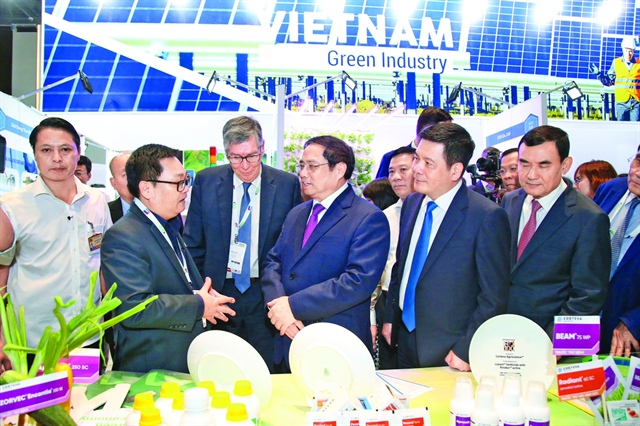
Prime Minister Pham Minh Chinh (third from right) and Minister of Industry and Trade Nguyen Hong Dien (second from right) talked with businesses at the Green Economy Forum & Exhibition 2022 |
Despite favorable export results, Minister Dien warned Vietnamese exporters of numerous difficulties. Specifically, global trade is being affected by growing geopolitical tensions and fierce strategic competition between major countries. Meanwhile, rising inflation has forced many governments to tighten their fiscal and monetary policies. Notably, global supply chains continue to risk disruptions that will affect import-export activities and the growth of the Vietnamese economy due to its high degree of openness (more than 200 percent). Moreover, many importing countries apply strict regulations in terms of environment and social responsibility on imports from Vietnam.
“To achieve sustainable export growth, Vietnamese businesses should promote green manufacturing and join global supply chains to meet strict technical requirements of importing markets. Further, businesses should improve product quality and packaging to enhance their competitiveness,” Minister Dien emphasized.
EuroCham Vietnam Vice Chair Jean-Jacques Bouflet said Vietnam has taken advantage of free trade agreements (FTAs) to diversify and increase exports. However, he added, Vietnam is one of the world’s most vulnerable countries to climate change, and therefore it should focus on ping a green, sustainable economy.
“FTAs involving Vietnam, especially the EU-Vietnam Free Trade Agreement (EVFTA), have commitments to green, sustainable development. EU consumers prefer to buy products made according to green, sustainable production processes. The EU also has very high technical standards for production. Therefore, Vietnamese businesses have to restructure production in this direction. EuroCham pledges to support and cooperate with Vietnam in this field,” Bouflet said, adding that European companies wish to take advantage of the EVFTA to increase investment in Vietnam.
Green growth strategy
The Communist Party and the State of Vietnam have put in place policies and mechanisms creating conditions to develop a green, circular and environmentally friendly economy. The latest one among those is Prime Ministerial Decision 493/QD-TTg approving Vietnam’s goods import-export strategy to 2030.
Businesses in many sectors have increased investment in production equipment and human resource training, while at the same time promoting digital and green transformation to meet the growing customer demand for environmentally friendly products and services.
|
|
Minister of Industry and Trade Nguyen Hong Dien: Shifting to a green economy is necessary for Vietnam to catch up with global development trends and implement its national strategy on green growth in the 2021-2030 period, with a vision to 2050, as well as Vietnam’s commitments at the 26th UN Climate Change Conference of the Parties (COP26). |
|
Bartosz Cieleszynski, Deputy Head of the Trade Section of the EU Delegation to Vietnam:
Creating green product flows
The EU-Vietnam Free Trade Agreement (EVFTA) has a chapter on green growth, helping create “flows” for green products and sustainable development. Vietnam will benefit from green technology application and development. Exporting green products is a promising way, and green technology is not beyond the reach of Vietnamese businesses. To produce green, sustainable products, Vietnamese businesses should apply green technology, starting from key export sectors such as agriculture, forestry and fishery.
Materials used to make products for export to Europe should also abide by sustainability principles and food safety regulations. Vietnamese authorities should help farmers and producers improve product quality to meet sustainable development criteria, including good agricultural practices and organic farming.
Other products such as footwear, textiles and garments can also participate in voluntary certification programs such as the Better Cotton Initiative (BCI), Global Organic Textile Standard (GOTS), and People for the Ethical Treatment of Animals (PETA). EU consumers and importers are very interested in these certification programs, which require biodiversity and soil conservation, sustainable water management, reduced use of pesticide, ensuring minimum and fair wages, elimination of child labor and animal maltreatment. Therefore, Vietnamese manufacturers and trade managers should pay attention to the shopping orientations of EU consumers.
|
Assoc. Prof. Dr. Nguyen Hong Quan, Director of the Institute for Circular Economy Development under the Vietnam National University, Ho Chi Minh City:
Opening new doors for exports
According to an International Labor Organization (ILO) 2022 report, a shift to green economy models can generate 24 million new jobs by 2030, and 63 percent of consumers consider sustainable development factors of brands when making purchasing decisions, according to a 2022 McKinsey survey. Nielsen’s 2022 Global Annual Marketing Report shows that the global market of green products is growing faster and bringing higher benefits compared with “brown” products of the same categories.
The green economy opens new doors for increased exports through green technology development, enhancing productivity and efficiency, strengthening investor trust, opening new markets, increasing budget revenues through green taxes, and reducing risks in the business environment.
To shift to a green economy, we have to attract investment in eco-industrial parks and build agro-industrial parks to prevent pollution, share energy resources, and develop transport, logistics, human resources and finance. Coordination is required between sectors such as agriculture, industry and trade, natural resources and environment, science and technology, planning and investment, finance, education, transport, and tourism. Breakthrough policies and mechanisms are needed in planning, project preparation, and investment attraction.
|
Truong Dinh Hoe, Secretary-General of the Vietnam Association of Seafood Exporters and Producers (VASEP):
Positive changes in the seafood sector
Green export strategies have strong impacts on the competitive advantages of seafood processing companies, making their products more attractive to foreign customers, helping build their green business image in the market.
This competitive advantage helps seafood companies achieve high financial efficiency. However, it will take time for seafood companies to implement green export strategies to build this competitive advantage. Therefore, businesses should be encouraged to take the initiative in promoting green production.
|
Nguyen Thi Lien, Deputy Director of the Phong Phu International Joint Stock Company:
Prioritizing environmentally friendly materials
In the past, the company had to use 40 liters of water to produce a pair of jeans. Today, with support of modern machinery and technology using ozone and laser, we need only four liters of water to make a similar product. Modern technology has also enabled the company to avoid using harmful chemicals, reduce power consumption and minimize industrial exhaust fumes, helping us create sustainable, user-friendly products and protect the environment.
The company also prioritizes the use of organic and recycled materials to meet consumer demand in the era of green, circular economy trends.
Sustainable production helps the company manage the consumption of power, water and chemicals, as well as the discharge of exhaust fumes, creating a better working environment. Our products meet growing customer requirements, enhancing the company’s prestige and helping it attract more orders in the context of increasingly fierce competition.



